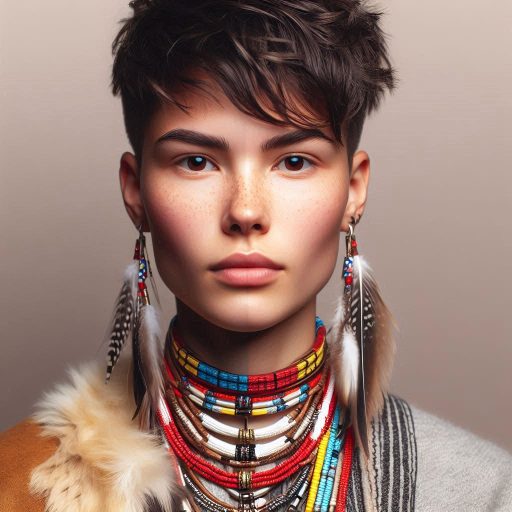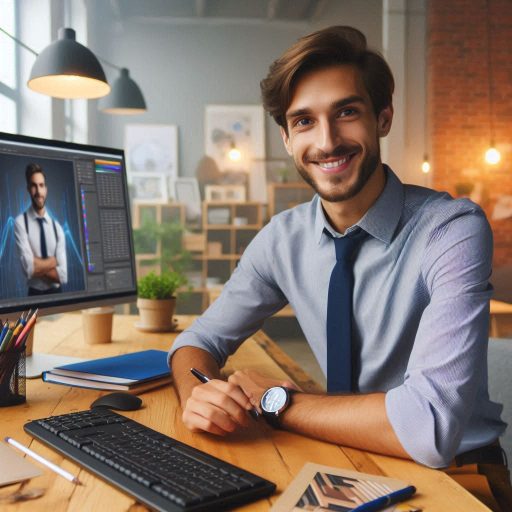Introduction
Character designers play a crucial role in the animation and entertainment industry.
They are responsible for creating memorable characters that resonate with audiences.
One such legendary character designer is Glen Keane, known for his work at Disney.
His creations include Ariel from “The Little Mermaid” and the Beast from “Beauty and the Beast.”
Character designers bring stories to life through their unique visual interpretations.
They establish a character’s personality and traits through their distinctive designs.
Iconic character designers have a lasting impact on pop culture and the entertainment industry.
Their creations become iconic symbols that stand the test of time.
Early Pioneers of Character Design
When it comes to character design, there are a few names that stand out as pioneers in the field.
These early influencers have shaped the way we think about and create characters in animation and beyond.
Walt Disney
Disney is perhaps the most iconic name in character design, known for creating timeless characters like Mickey Mouse and Donald Duck.
His attention to detail and ability to create characters that resonate with audiences of all ages have solidified his place in history.
Disney’s commitment to storytelling through characters has set a standard for character design in animation and entertainment.
Tex Avery and Chuck Jones
Tex Avery and Chuck Jones are two other animators who have left a lasting impact on character design.
Avery is known for his exaggerated, comedic characters like Droopy and the Wolf, pushing the boundaries of traditional animation.
Chuck Jones, on the other hand, is best known for his work with Looney Tunes characters like Bugs Bunny and Daffy Duck.
Both animators brought a unique style and perspective to character design, paving the way for future generations of animators and designers.
In essence, the early pioneers of character design, including Walt Disney, Tex Avery, and Chuck Jones, have shaped the way we approach character design in animation and beyond.
Their innovative techniques and memorable characters continue to inspire creatives around the world.
Read: Character Design Challenges: Overcoming Creative Blocks
Transform Your Career Today
Unlock a personalized career strategy that drives real results. Get tailored advice and a roadmap designed just for you.
Start NowContemporary masters of character design
When it comes to modern character design, two names stand out in the industry: Hayao Miyazaki and Genndy Tartakovsky.
Let’s take a closer look at their groundbreaking work:
Hayao Miyazaki
Miyazaki, the co-founder of Studio Ghibli, is known for his intricate and captivating character designs.
His work in films such as “Spirited Away” and “My Neighbor Totoro” has earned him international acclaim.
Miyazaki’s characters are often depicted with a sense of whimsy and fantastical elements that resonate with audiences of all ages.
He blends traditional hand-drawn animation techniques with modern digital tools to create visually stunning and emotionally resonant characters.
Through his work, Miyazaki has pushed the boundaries of character design, exploring themes of nature, spirituality, and the human experience.
Genndy Tartakovsky
Tartakovsky, known for creating iconic characters such as Dexter from “Dexter’s Laboratory” and Samurai Jack, is a pioneer in the field of character design.
His distinctive style, characterized by bold lines and dynamic shapes, has set him apart from other animators.
Tartakovsky has embraced new technologies in his work, experimenting with 3D animation and computer-generated imagery to enhance his storytelling.
His characters are often minimalist yet expressive, conveying complex emotions and narratives through simple and stylized designs.
By exploring different animation techniques and styles, Tartakovsky continues to push the boundaries of character design and storytelling in the digital age.
In fact, both Hayao Miyazaki and Genndy Tartakovsky have made significant contributions to the world of character design by pushing boundaries, embracing new technologies, and creating memorable and impactful characters that resonate with audiences worldwide.
Read: Introduction to the Printmaking Art Profession
The Process of Character Design
Importance of Research and Development
- Research is crucial in understanding the audience’s preferences and trends in character design.
- Studying past successful character designs helps in avoiding clich‘s and creating original concepts.
- Through research, designers can gather inspiration from various sources, such as nature, culture, and art.
- Development involves brainstorming ideas, sketching initial concepts, and refining them based on feedback.
Role of Storytelling in Shaping Character Design Choices
- Characters are essential for conveying the narrative and connecting with the audience on an emotional level.
- Storytelling guides character development by defining their personality, motivations, and relationships with other characters.
- Characters should reflect the story’s themes and contribute to the overall message or moral of the narrative.
- Story-driven character design ensures consistency in their actions, appearance, and growth throughout the plot.
Impact of iconic characters on popular culture
The lasting influence of characters like Mickey Mouse and Bugs Bunny on society
Iconic characters such as Mickey Mouse and Bugs Bunny have had a profound and lasting influence on society.
These characters have become more than just animated figures; they are cultural icons that transcend generations.
They have ingrained themselves in popular culture, becoming recognizable symbols of their respective brands.
Mickey Mouse, for example, is not just a cartoon character but a symbol of Disney and all its entertainment empire.
Similarly, Bugs Bunny is not just a rabbit but a representation of Warner Bros. and its rich history of animation.
How iconic characters have become symbols of their respective brands
The impact of these iconic characters goes beyond mere entertainment; they have influenced fashion, merchandise, and even language.
Transform Your Career Today
Unlock a personalized career strategy that drives real results. Get tailored advice and a roadmap designed just for you.
Start NowFor example, Mickey Mouse’s silhouette is instantly recognizable, appearing on everything from t-shirts to handbags.
Similarly, Bugs Bunny’s catchphrase “What’s up, Doc?” has become a part of everyday vernacular.
These characters have seeped into every aspect of our lives, shaping our tastes, preferences, and even our identities.
They have become symbols of nostalgia, reminding us of simpler times and bringing a sense of comfort and familiarity.
In fact, iconic characters like Mickey Mouse and Bugs Bunny have left an indelible mark on popular culture.
They have become more than just cartoons; they are cultural touchstones that connect us to our past and shape our future.
Their influence can be seen in every facet of society, from entertainment to fashion to everyday language.
As symbols of their respective brands, they embody the essence of timelessness and enduring appeal.
These characters will continue to captivate audiences for generations to come, cementing their place in the annals of popular culture.
Read: Creative Inspirations: Where Do Designers Find Ideas?

Diversity and representation in character design
Importance of creating diverse and inclusive characters in media
Creating diverse and inclusive characters in media is crucial for representation and authenticity.
- It allows individuals from different backgrounds to see themselves reflected in the stories they consume.
- It promotes empathy and understanding by showcasing different perspectives and experiences.
- It challenges stereotypes and biases by breaking away from traditional norms and expectations.
Character Designers Who Champion Diversity in Their Work
- Shane Prigmore: Known for creating characters with different body types, ethnicities, and personalities.
- Rebecca Sugar: Introduced LGBTQ+ representation in “Steven Universe” through diverse characters and storylines.
- Lauren Faust: Emphasized female empowerment and diversity in shows like “My Little Pony: Friendship Is Magic.”
Read: Building an Online Presence for Ceramic Artists
Challenges faced by character designers
Character designers face a variety of challenges in their line of work, from constraints and limitations to fierce competition in the industry.
Let’s take a closer look at some of the obstacles they encounter and how they navigate through them:
Addressing constraints and limitations
One of the major challenges for character designers is working within the parameters set by clients or projects.
These constraints may include specific requirements for the character’s appearance, personality, or background.
Designers often have to balance artistic creativity with meeting the practical needs of the project.
Working within these limitations can be challenging, but it also pushes designers to think outside the box and find innovative solutions.
Overcoming obstacles to bring vision to life
Despite facing constraints, character designers continuously strive to bring their unique vision to life.
They may need to adapt their initial ideas to fit the requirements of the project while still maintaining their creative integrity.
Transform Your Career Today
Unlock a personalized career strategy that drives real results. Get tailored advice and a roadmap designed just for you.
Start NowDesigners often collaborate with other team members, such as animators and writers, to ensure a cohesive vision for the character.
Feedback and revisions are common in the design process, and designers must be open to making adjustments to improve their work.
Ultimately, character designers must navigate through a complex web of challenges to create memorable and impactful characters that resonate with audiences.
It’s a demanding and competitive field, but the rewards of seeing their creations come to life make it all worthwhile.
Learning from the masters
Aspiring character designers can learn valuable lessons from iconic designers in the industry.
Tips and Advice for Aspiring Character Designers
- Study the work of iconic designers to understand their design choices and techniques.
- Experiment with various styles and approaches to find your unique voice as a designer.
- Seek feedback from peers and professionals to improve and refine your designs.
- Practice regularly to hone your skills and develop a strong portfolio of work.
- Stay curious and open to new ideas, trends, and technologies in character design.
Emulating the techniques of established professionals can help aspiring designers accelerate their growth and development.
The Importance of Studying and Emulating Techniques
- By studying the work of iconic designers, aspiring artists can gain insights into the industry’s best practices.
- Emulating techniques allows designers to understand the thought process behind successful character designs.
- Learning from the masters can provide inspiration and motivation to push boundaries and experiment creatively.
- Studying and emulating techniques help aspiring designers develop a strong foundation in character design principles.
- Established professionals have years of experience and knowledge to impart valuable lessons to newcomers.
Overall, aspiring character designers can benefit greatly from learning from the masters and applying their insights to enhance their own work.
By studying iconic designers and emulating their techniques, designers can elevate their skills and establish themselves as successful professionals in the industry.
Gain More Insights: Top Industrial Design Competitions to Enter
Conclusion
Iconic character designers play a crucial role in shaping the world of animation and entertainment.
Their creative vision and unique style set the standard for character design in various industries.
As readers, we can continue learning from these masters by studying their techniques and understanding the principles behind their iconic characters.
By doing so, we can push the boundaries of character design and strive to create our own unforgettable characters.
Let’s not only admire the work of iconic character designers but also be inspired by their legacy to innovate and create new and exciting characters that will leave a mark on the world of animation and entertainment.
[E-Books for Sale]
The Big Book of 500 High-Paying Jobs in America: Unlock Your Earning Potential
$19.99 • 500 High-Paying Jobs • 330 pages
Explore 500 high-paying jobs in America and learn how to boost your career, earn more, and achieve success!
See All 500 High-Paying Jobs of this E-Book
1001 Professions Without a Degree: High-Paying American Jobs You Can Start Now
$19.99 • 1001 Professions Without a Degree • 174 pages
Discover 1001 high-paying jobs without a degree! Unlock career tips, skills, and success strategies for just $19.99!




